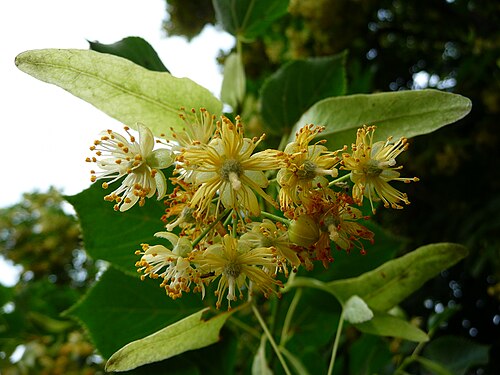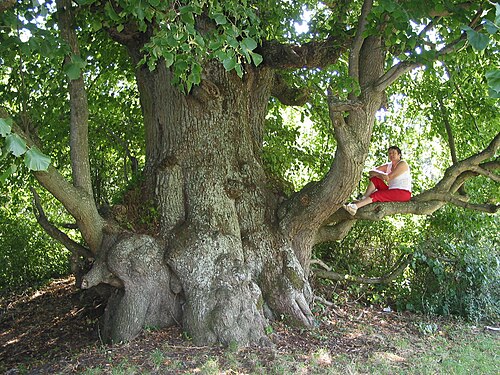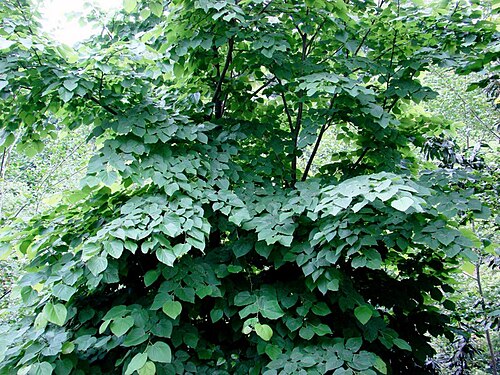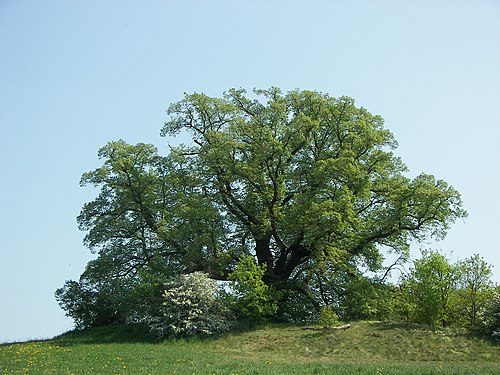Difference between revisions of "Tilia platyphyllos"
| Line 26: | Line 26: | ||
|max_zone=9 | |max_zone=9 | ||
|image=Tilia platyphyllos(01).jpg | |image=Tilia platyphyllos(01).jpg | ||
| − | |image_width= | + | |image_width=200 |
|image_caption=Large-leaved Lime (''Tilia platyphyllos'') | |image_caption=Large-leaved Lime (''Tilia platyphyllos'') | ||
}} | }} | ||
'''''Tilia platyphyllos''''' is a deciduous [[tree]] native to much of [[Europe]], including locally in southwestern [[Great Britain]], growing on [[Lime (mineral)|lime]]-rich soils. The common name '''Large-leaved Linden''' is in standard use throughout the English-speaking world except in Britain, where it has largely (but not universally) been replaced{{Verify source|date=April 2010}}<!-- or is it the other way around ("linden" replacing the original "lime")? Both terms seem to date to the Early Modern era, but "linden" seems to have been an adjective "made from lime wood" at first?! --> by the name '''Large-leaved Lime'''. It is frequently planted as an ornamental tree in parks, or as a shade tree or a lawn tree. It has been introduced in the US (New England). | '''''Tilia platyphyllos''''' is a deciduous [[tree]] native to much of [[Europe]], including locally in southwestern [[Great Britain]], growing on [[Lime (mineral)|lime]]-rich soils. The common name '''Large-leaved Linden''' is in standard use throughout the English-speaking world except in Britain, where it has largely (but not universally) been replaced{{Verify source|date=April 2010}}<!-- or is it the other way around ("linden" replacing the original "lime")? Both terms seem to date to the Early Modern era, but "linden" seems to have been an adjective "made from lime wood" at first?! --> by the name '''Large-leaved Lime'''. It is frequently planted as an ornamental tree in parks, or as a shade tree or a lawn tree. It has been introduced in the US (New England). | ||
| + | |||
| + | [[Image:Tilia platyphyllos(02).jpg|thumb|180px|leaves]] | ||
It is a narrowly domed tree with a moderate growth rate, and can eventually attain a height of 40 m. The reddish-brown young [[Plant stem|stems]] later develop dark gray [[bark]] with fine fissures and furrows. The branches spread upwards at wide angles. The [[twig]]s are reddish-green and slightly pubescent. | It is a narrowly domed tree with a moderate growth rate, and can eventually attain a height of 40 m. The reddish-brown young [[Plant stem|stems]] later develop dark gray [[bark]] with fine fissures and furrows. The branches spread upwards at wide angles. The [[twig]]s are reddish-green and slightly pubescent. | ||
| − | |||
| − | |||
The [[foliage]] consists of simple, alternately arranged [[Leaf|leaves]]. As indicated by its common name, this tree has larger leaves than the related ''[[Tilia cordata]]'' (Small-leaved Linden), 6 to 9 cm (exceptionally 15 cm). They are ovate to cordate, mid to dark green above and below, with white downy hair on the underside, particularly along the veins, tapering into a mucronate tip. The margin is sharply serrate, and the base cordate; the venation is palmate along a midrib. The pubescent [[Petiole (botany)|petiole]] is usually 3-4 cm long, but can vary between 1.5-5 cm. The autumn foliage is yellow-green to yellow. | The [[foliage]] consists of simple, alternately arranged [[Leaf|leaves]]. As indicated by its common name, this tree has larger leaves than the related ''[[Tilia cordata]]'' (Small-leaved Linden), 6 to 9 cm (exceptionally 15 cm). They are ovate to cordate, mid to dark green above and below, with white downy hair on the underside, particularly along the veins, tapering into a mucronate tip. The margin is sharply serrate, and the base cordate; the venation is palmate along a midrib. The pubescent [[Petiole (botany)|petiole]] is usually 3-4 cm long, but can vary between 1.5-5 cm. The autumn foliage is yellow-green to yellow. | ||
| Line 61: | Line 61: | ||
==Gallery== | ==Gallery== | ||
| − | + | <gallery perrow=5> | |
| − | + | File:Blüten der Sommerlinde.JPG | |
| − | + | File:Geschlossene Blütenknospen der Sommerlinde.JPG | |
| − | + | File:Tilia platyphyllos.jpg | |
| − | + | File:Sommerlinde (Tilia platyphyllos).jpg | |
| − | + | File:Tilia platyphyllos11.JPEG | |
| + | File:Tilia-platyphyllos-leaves.JPG | ||
| + | File:Tilia platyphyllos JPG2a.jpg | ||
| + | File:Conjoux JPG01.jpg | ||
| + | File:Macon AR1JPG.jpg | ||
| + | File:Büyük yapraklı ıhlamur2.JPG | ||
| + | File:Tilia platyphyllos 001.jpg | ||
| + | File:Emptinne AR1JPG.jpg | ||
</gallery> | </gallery> | ||
Latest revision as of 21:27, 27 April 2010
| Habit | tree
| |
|---|---|---|
| Height: | ⇕ | 100 ft"ft" can not be assigned to a declared number type with value 100. |
| Width: | ⇔ | 50 ft"ft" can not be assigned to a declared number type with value 50. |
| Lifespan: | ⌛ | perennial |
| Bloom: | ❀ | early summer, mid summer, late summer |
| Exposure: | ☼ | sun |
|---|---|---|
| Features: | ✓ | flowers |
| USDA Zones: | 5 to 9 | |
| Flower features: | ❀ | orange, yellow |
|
Tilia > |
Scop. > |
Tilia platyphyllos is a deciduous tree native to much of Europe, including locally in southwestern Great Britain, growing on lime-rich soils. The common name Large-leaved Linden is in standard use throughout the English-speaking world except in Britain, where it has largely (but not universally) been replacedTemplate:Verify source by the name Large-leaved Lime. It is frequently planted as an ornamental tree in parks, or as a shade tree or a lawn tree. It has been introduced in the US (New England).
It is a narrowly domed tree with a moderate growth rate, and can eventually attain a height of 40 m. The reddish-brown young stems later develop dark gray bark with fine fissures and furrows. The branches spread upwards at wide angles. The twigs are reddish-green and slightly pubescent.
The foliage consists of simple, alternately arranged leaves. As indicated by its common name, this tree has larger leaves than the related Tilia cordata (Small-leaved Linden), 6 to 9 cm (exceptionally 15 cm). They are ovate to cordate, mid to dark green above and below, with white downy hair on the underside, particularly along the veins, tapering into a mucronate tip. The margin is sharply serrate, and the base cordate; the venation is palmate along a midrib. The pubescent petiole is usually 3-4 cm long, but can vary between 1.5-5 cm. The autumn foliage is yellow-green to yellow.
The small, fragrant, yellowish-white flowers are arranged in drooping, cymose clusters in groups of 3 to 4. Their whitish-green, leaf-like bracts have an oblong-obovate shape. The geniculate peduncles are between 1.5-3 cm long. The hermaphroditic flowers have 5 sepals and 5 tepals, numerous stamens, but no staminodes. The superior ovary is 2-10 locular with one smooth style. The flowers are pollinated by bees.
The fruit is a small, round, tomentose, cream-colored nutlet with a diameter of 1 cm or less. It has a woody shell with 3-5 ridges.
Read about Tilia platyphyllos in the Standard Cyclopedia of Horticulture
|
|---|
|
Tilia platyphyllos, Scop. (T. grandifolia, Ehrh. T. europaea, Linn., in part). Large-leaved Lime. Tree, to 120 ft.: young branchlets pubescent, older glabrous: lvs. orbicular-ovate, abruptly acuminate, obliquely cordate at the base, regularly serrate, dull green and short-pubescent or glabrous above, light green and pubescent beneath, 3-4 in. long; petioles stout, hairy: fls. in usually 3-fld. pendulous cymes; petals oblanceolate, longer than sepals; stamens 30; style glabrous: fr. globose, ovoid or pyriform, 3-5- ribbed, apiculate, tomentose, thick-shelled. June; the earliest species to bloom. Eu.—Very variable; some of the most important varieties are the following: Var. pyramidalis, Kirchn. Of narrow pyramidal habit. Var. corallina, Dipp. (var. rubra, Hort.). Young branches red. Var. aurea, Kirchn. Young branches golden yellow. Var. laciniata, Henry (var. asplenifolia, Kirchn. var. filicifolia, Hort. T. europaea var T. laciniata, Loud.). Lvs. deeply and irregularly cut. Var. vitifolia, Simonkai. Lvs. slightly 3-lobed or indistinctly lobed.—This species is the strongest grower and in this country often sold as T. europaea. It is more impatient of drought than most other species and therefore not to be recommended as a street tree. CH
|
Cultivation
- Do you have cultivation info on this plant? Edit this section!
Propagation
- Do you have propagation info on this plant? Edit this section!
Pests and diseases
- Do you have pest and disease info on this plant? Edit this section!
Varieties
There are several cultivars offered commercially in nurseries, including 'Rubra' (red twiiged) and 'Tortuosa' (twisted branches).
Tilia platyphyllos readily hybridises with Tilia cordata, the hybrid being the Common Lime Tilia × europaea (syn. Tilia × vulgaris).
Gallery
References
- Standard Cyclopedia of Horticulture, by L. H. Bailey, MacMillan Co., 1963
External links
- w:Tilia platyphyllos. Some of the material on this page may be from Wikipedia, under the Creative Commons license.
- Tilia platyphyllos QR Code (Size 50, 100, 200, 500)













